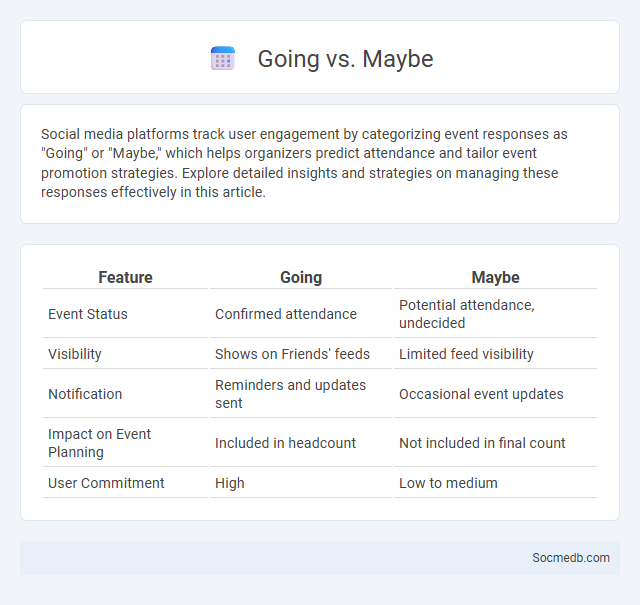
Photo illustration: Going vs Maybe
Social media platforms track user engagement by categorizing event responses as "Going" or "Maybe," which helps organizers predict attendance and tailor event promotion strategies. Explore detailed insights and strategies on managing these responses effectively in this article.
Table of Comparison
| Feature | Going | Maybe |
|---|---|---|
| Event Status | Confirmed attendance | Potential attendance, undecided |
| Visibility | Shows on Friends' feeds | Limited feed visibility |
| Notification | Reminders and updates sent | Occasional event updates |
| Impact on Event Planning | Included in headcount | Not included in final count |
| User Commitment | High | Low to medium |
Understanding Event Responses: Going, Maybe, and RSVP
Social media platforms streamline event planning by offering clear RSVP options such as Going, Maybe, and RSVP, enabling hosts to gauge attendance accurately. The Going response signifies confirmed attendance, while Maybe indicates uncertainty or potential availability, allowing organizers to anticipate fluctuating guest lists. RSVP functions as a prompt for recipients to respond, ensuring improved communication and event management through timely confirmations or declines.
What Does "Going" Mean for Event Attendance?
Going" on social media platforms like Facebook indicates a user's confirmed attendance to an event, helping organizers estimate participant numbers and plan resources effectively. This status also influences social proof, encouraging more users in a network to commit by showcasing event popularity. Tracking the "Going" count provides valuable data on engagement and can boost event visibility through algorithmic promotion.
Interpreting "Maybe": The Middle Ground Response
Interpreting "maybe" in social media interactions reveals a nuanced middle ground often signaling uncertainty or polite hesitation rather than outright refusal. This response serves as a strategic ambiguity, allowing users to maintain relationships while avoiding commitment or confrontation. Understanding "maybe" enhances communication clarity and helps gauge true intentions behind online engagements.
RSVP Explained: Tradition and Modern Usage
RSVP, derived from the French phrase "Repondez s'il vous plait," historically required guests to confirm attendance for formal events, ensuring accurate headcounts and proper preparations. In modern social media contexts, RSVP functionality enables users to instantly respond to event invitations on platforms like Facebook and LinkedIn, streamlining event planning and enhancing communication. Digital RSVPs provide real-time updates on guest lists, improving organization and engagement for both virtual and in-person gatherings.
Social Etiquette for Responding to Invitations
When responding to social media invitations, timely and polite replies demonstrate respect and consideration for the sender's effort. Your response should be clear, confirming your attendance or offering a gracious decline to avoid misunderstandings. Proper social etiquette online strengthens relationships and enhances your digital reputation.
Pros and Cons of Each Response Option
Social media platforms offer various pros and cons depending on the response option you choose. Public comments foster open dialogue and increased visibility but may expose your brand to negative feedback and trolls. Private messages provide personalized interaction and confidentiality but limit reach and require more resources to manage effectively. Choosing the right response channel can enhance your online reputation while balancing engagement and control.
Host Perspective: Managing Going, Maybe, and RSVP Replies
Managing Going, Maybe, and RSVP replies effectively streamlines event planning and enhances your ability to gauge attendee interest. Prioritizing clear communication and timely updates ensures accurate headcounts and better resource allocation for your event. Leveraging social media event tools allows you to track responses in real time, making your hosting experience more organized and efficient.
Best Practices for Event Invitations on Social Platforms
Utilize clear, engaging visuals and concise, action-oriented language to capture attention on social media event invitations. Incorporate platform-specific features like Facebook's RSVP buttons and Instagram Stories countdowns to boost interaction and reminder effectiveness. Target relevant audience segments through hashtag optimization and paid promotions to maximize reach and attendance.
Impact of Responses on Event Planning and Logistics
Responses on social media significantly shape event planning and logistics by providing real-time feedback that helps you adjust scheduling, capacity, and resource allocation to match attendee needs. Monitoring trends and sentiment analysis allows organizers to anticipate potential issues and optimize communication strategies for smoother execution. Leveraging social media insights enhances decision-making efficiency, reduces risks, and improves overall event success.
Tips for Guests: Choosing and Communicating Your Attendance Status
Guests should clearly select their attendance status on social media event pages, such as "Going," "Interested," or "Not Going," to help organizers gauge accurate headcounts. Providing timely updates if plans change maintains transparent communication and avoids confusion. Engaging with event posts by commenting or sharing also signals commitment and helps foster community anticipation.
 socmedb.com
socmedb.com